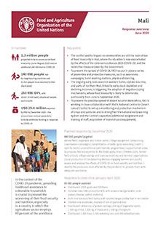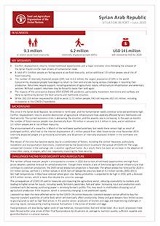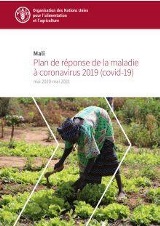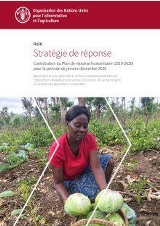Publications

FAO-WFP early warning analysis of acute food insecurity hotspots (July 2020)
07/2020
This report is part of a series of analytical products produced under the Global Network Against Food Crises initiative co-led by EU, FAO, and WFP to enhance and coordinate the generation and sharing of evidence‑based information and analysis for preventing and addressing food crises.
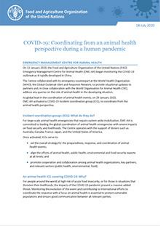
COVID-19: Coordinating from an animal health perspective during a human pandemic
07/2020
FAO's Emergency Management Centre for Animal Health (EMC-AH) activated an Incident Coordination Group (ICG) in January 2020 to coordinate and monitor the COVID-19 event from an animal health perspective.
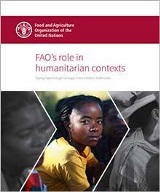
FAO's role in humanitarian contexts
07/2020
The number of people experiencing hunger – both chronic and acute – has been persistently high in recent years. The 2019 edition of The State of Food Security and Nutrition in the World indicates that the number of people facing hunger rose to 820 million in 2018, up from 811 million in 2017.
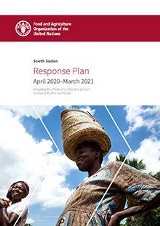
South Sudan: Response Plan, April 2020–March 2021
07/2020
Years of conflict, chronic vulnerabilities and weak essential services have deteriorated the food security and livelihood situation in South Sudan. Now, the COVID-19 outbreak threatens to paralyze an already fragile food system and negatively impact more than 6.5 million people who remain vulnerable.
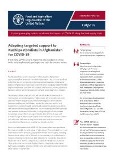
Adapting targeted support to Kuchi pastoralists in Afghanistan for COVID-19
07/2020
Kuchi pastoralists, numbering around 2.4 million people in Afghanistan, are one of the region’s most vulnerable groups.
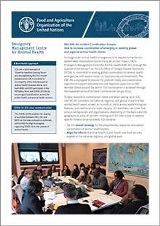
FAO EMC-AH Incident Coordination Groups
06/2020
This 2-pager presents the Incident Coordination Groups (ICGs) activated and led by FAO’s Emergency Management Centre for Animal Health (EMC-AH) and provides a summary of the activities carried out under those ICGs, as well as their impacts.
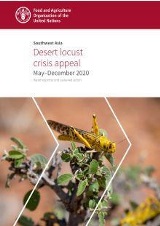
Southwest Asia: Desert locust crisis appeal (May–December 2020)
05/2020
The desert locust crisis appeal for Southwest Asia details the funding needed by FAO to combat this destructive pest that is threatening countries across the region, and Islamic Republic of Iran and Pakistan in particular.
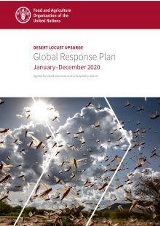
Desert locust upsurge: Global Response Plan (January–December 2020)
05/2020
The Global Response Plan presents an overview of FAO's ongoing desert locust response activities, as well as funding needs for the remainder of 2020 in order to: sustain ongoing operations and livelihoods support in the Greater Horn of Africa and Yemen, scale up operations and assistance in southwest Asia where the locust is an increasing threat, and prepare for a potential future outbreak in West Africa and the Sahel.

West Africa: Desert locust crisis appeal (May–December 2020)
05/2020
Recent forecasts by the Food and Agriculture Organization of the United Nations (FAO) have indicated a risk of locust invasion in West Africa from June 2020.
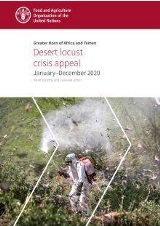
Greater Horn of Africa and Yemen: Desert locust crisis appeal (January–December 2020)
05/2020
The worst desert locust outbreak in decades is underway in the Greater Horn of Africa and Yemen, where tens of thousands of hectares of cropland and pasture have been damaged in Djibouti, Eritrea, Ethiopia, Kenya, Somalia, South Sudan, the Sudan, Uganda, the United Republic of Tanzania and Yemen, with potentially severe consequences for agriculture-based livelihoods in contexts where food security is already fragile.
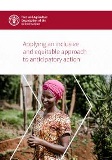
Applying an inclusive and equitable approach to anticipatory action
05/2020
An inclusive approach to anticipatory action will have a nuanced and context-specific understanding of the ways inequalities impact vulnerability and resilience.

Addressing the impacts of COVID-19 in food crises (May update)
05/2020
At the beginning of April, the 2020 edition of the Global Report on Food Crises was issued, presenting a stark warning for the future.
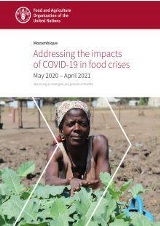
Mozambique: Addressing the impacts of COVID-19 in food crises (May 2020 – April 2021)
05/2020
This national response plan details FAO's programme of work in Mozambique to help combat the fallout of COVID-19 on an already unfolding food crises among vulnerable sections of the population.

Social Protection and COVID-19 response in rural areas
05/2020
Measures to contain the spread of COVID-19 include strong restrictions of movement which dramatically change daily lives and impact agricultural livelihoods.
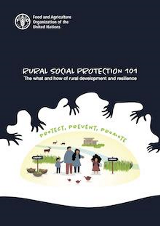
Rural Social Protection 101: The what and how of rural development and resilience
05/2020
In an effort to quickly and effectively describe the role - and different perspectives - of social protection in the context of FAO's mandate, this two-sided infographic focuses on the work we carry out with rural populations on one side, and with governments and other relevant players on the other.


